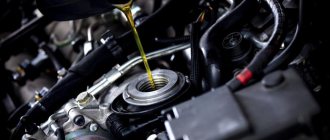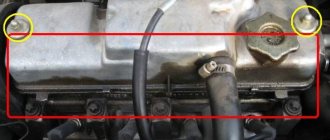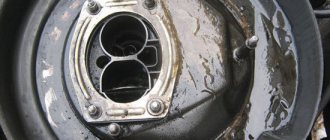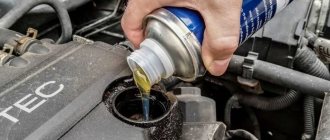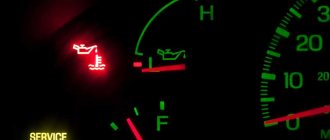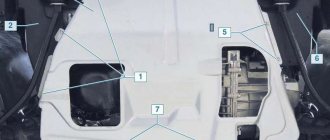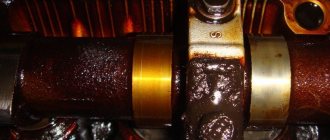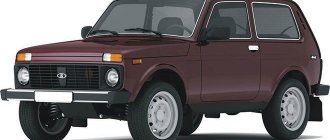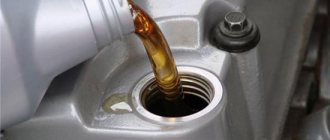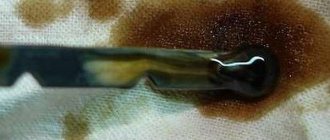Published: 01/28/2021
- Check to see if there is more oil than needed
- What to look for when the lubrication level is high
- Consequences of overflow
- Increased lubricant consumption due to antifreeze ingress
- Engine oil level rises
- Checking the level of lubricants poured into the engine
- What is the danger of exceeding the amount of oil in the engine and is it good?
- How to properly add oil to the engine
- Tips and tricks
- What to do with excess oil?
- Is it worth doing engine chip tuning?
- Why did the engine oil level increase? 4 reasons
- Final part
- What to do if you overfill the engine with oil
Check to see if there is more oil than needed
First you need to check whether it is true that there is more oil in the engine than required. Measurements should only be taken as follows:
- the machine is standing on a flat, stable surface;
- pressure indicators in all tires are the same;
- engine temperature - about 50°C;
- the car is unloaded, empty.
Checking the oil level in the engine
The algorithm for measuring the lubricant level is as follows:
- Remove the oil dipstick and wipe it with a clean cloth.
- Insert it back all the way.
- After waiting about 5 seconds, you can check - this is enough for the level to be clearly visible on the dipstick.
- Remove it, preferably without touching the walls of the hole when removing it.
- The dipstick has notches for minimum and maximum values - the norm will be around the middle.
Marks on the dipstick
When the lubricant indicator is greater than the maximum, there is more of it in the engine than necessary.
Some manufacturers make several marks on the dipstick depending on the engine temperature.
How does high oil level affect a diesel engine?
When technical fluids are combined with oil, the latter loses its viscous consistency, due to which friction between engine parts is neutralized. The reduction in friction occurs under the influence of a thin film created by oil on the surface of the parts. In addition to the change in viscosity, the oil acquires an unusual color and a specific smell appears. However, the most important negative consequence is that the oil loses its ability to form a protective film that reduces wear on engine parts.
The entry into the combustion chamber of oil mixed with technical fluids and having lost its basic properties leads to a decrease in engine power. Smoke with a pungent odor begins to come out of the exhaust pipe, and soot deposits form on the surfaces of the combustion chamber itself and the exhaust system.
The engine oil consumption rate is experimentally established by the manufacturer for each new model. If the consumption rate is reached, the lubricant must be replaced. Usually the car has a special dipstick with divisions for measuring the oil level. An oil level below or above the minimum and maximum values indicates a problem with lubrication of parts, which leads to premature engine wear.
What to look for when the lubrication level is high
It turns out that a high level can arise as a result of a banal overflow of oil into the engine. Also, possible mistakes should not be ruled out, especially among novice car owners:
- when replacing or adding lubricant, the car was not placed on a flat horizontal platform;
- the lubricant was added, then the dipstick was immediately removed to check the level, without taking into account that it was necessary to wait for the time during which the residues still flowed into the pan;
- the level was checked “hot” immediately after stopping the internal combustion engine, etc.
In this case, excess lubricant must be removed immediately, which will avoid foaming, oil squeezing out through oil seals, gaskets and seals, oiling of the turbocharger, and penetration of lubricant into other systems and components.
Let's move on to the second reason. To understand why the oil level in the engine increased in this case, it is enough to evaluate the operation of the engine, as well as the condition of its power system
We will not consider outdated carburetor internal combustion engines separately, focusing on injection power units. However, a number of problems may be common to both types
First of all, disturbances in engine operation (triggering, malfunctions, etc.) parallel to a significant increase in fuel consumption will indicate that the fuel-air mixture does not burn in individual cylinders for one reason or another. In this case, part of the fuel will actually “fly out” into the exhaust pipe, while the other part will inevitably flow into the crankcase through the piston rings.
If we add to this that the engine itself may be worn out (low compression, stuck rings, damage to the cylinder bore, obvious smoke from a grayish exhaust, etc.), then the total amount of fuel in the oil often turns out to be quite large.
In this case, the oil smells like gasoline, becomes highly flammable and dilutes greatly, which can be reliably determined during testing. Also, with such diluted lubricant, the engine runs very noisily, knocking noises may occur, and the unit itself will quickly fail.
Currently reading
In this case, fuel in the oil is only a consequence of breakdowns, and the root causes of the engine malfunction itself can be different. For example, problems with mixture formation (the mixture becomes over-rich in gasoline and loses its ability to ignite), lack of spark on the spark plugs, low compression, leaking injectors (when closed injectors “pour” fuel), etc.
In any case, the engine cannot be operated with such a problem, since the lubricant loses its protective, antifriction and other properties. The power unit must be repaired immediately, eliminating the main cause or a whole set of problems due to which fuel enters the engine crankcase.
Finally, the third reason. In this case, working fluid from the cooling system enters the engine oil. This is indicated by a decrease in the coolant level in the expansion tank, an increase in the oil level, as well as a water-oil emulsion under the oil filler cap.
If antifreeze or antifreeze is found in the oil, then measures must be taken immediately. Such a malfunction is usually caused by a breakdown of the cylinder head gasket, as well as the appearance of cracks in the cylinder block or cylinder head. An indirect sign is white smoke from the exhaust pipe.
The danger of mixing oil and antifreeze is that the result is not only a loss of oil properties, but also the formation of sediment. This deposit is the result of a chemical reaction between the additives in the base engine oil and the component package in the coolant.
The emulsion clogs the oil passages, and solid particles significantly increase wear on the crankshaft bearings and other elements. Ultimately, the engine becomes severely damaged and begins to knock as it suffers from oil starvation, to which is added the damage from the above-mentioned particulate matter.
In such a situation, it is necessary to repair the power unit, after which it is mandatory to thoroughly flush the engine to remove the emulsion in the oil. To do this, it is optimal to use special flushing oils, rather than quick “five-minute” flushes into used lubricant.
It is also advisable to reduce the subsequent replacement interval for fresh lubricant by 50% in order to eliminate the negative impact and premature aging of the oil after contact with the remnants of the emulsion and flushing oil that are not drained from the internal combustion engine.
Motorcycles
The problem of exceeding the oil level is relevant not only for cars, but also for two-wheeled mechanized vehicles, as well as ATVs.
This applies to the vehicles listed above, both four-stroke wet-sump power units and two-stroke ones (in which oil is added to gasoline).
For 4-stroke engines
Each engine has a special breather installed to remove crankcase gases. While driving, excess oil (especially on a bad road) will come out through it. As a result, normal loss of lubrication occurs.
The remaining problems are similar to those listed above.
For 2-stroke engines
The same consequences as discussed above are relevant here, but we are no longer talking about exceeding the level.
For such engines, it is important to maintain the correct proportion of 1 to 50. This means that for 5 liters of gasoline you need to add about 100 million of engine lubricant.
Compliance with this rule is very important, because the appearance of excess oil leads to the following problems:
- The appearance of soot.
- Throwing candles.
- Difficulty starting the motorcycle engine.
- Malfunctions on the road (the engine periodically stalls).
- The appearance of bluish smoke from the exhaust system.
Consequences of overflow
Overfilling the engine with oil has consequences that can affect the performance of the equipment. These include:
- The formation of deposits in internal combustion engine cylinders as a result of the combustion of a large amount of oil. Carbon deposits on the internal parts negatively affect the hollow piston of the engine, reducing its performance and service life.
- Increased lubricant consumption and temperature. Excessive oil causes the crankshaft to foam, causing the oil temperature and flow rate to increase.
- Increased fuel consumption. The reason for high fuel consumption lies in the difficulty of starting the power plant, especially when a diesel unit is installed. The driver feels that the engine is losing power and presses the fuel pedal. As a result of such operation, fuel consumption increases.
- Additional load on the oil pump and filter. If there is excess lubrication, the pressure in the oil system increases and the load on all components of the system increases. Operation in high pressure mode may result in premature failure of the oil filter and pump. Accordingly, significant financial costs for their restoration.
- Air intake into hydraulic compensators. Excess oil will foam the crankshaft, resulting in reduced lubricant uniformity. This will cause airing of the hydraulic compensators and increase the load on them and on the gas distribution mechanism.
- Carbon deposits on spark plugs. With excess oil and high pressure, a significant layer of carbon deposits forms on the spark plugs. As a result, the performance of the spark plugs decreases, the injector produces pulsed fuel emissions and the spark plugs are flooded. When filling spark plugs, diesel or gasoline will escape along with the oil film through the piston rings into the lubrication system.
- Muffler clogged. The increased volume of combustion elements settles in the muffler. This is dangerous because the power plant loses power. The muffler's service life is reduced.
- Increased amount of exhaust gases and their toxicity. If there is excess lubricant, the volume of its combustion increases. As a result, the amount of exhaust gases increases and their quality deteriorates. The release of toxic substances into the environment is increasing. This is less dangerous in the summer, and unsafe in the winter, especially in the garage.
- Failure of sealing elements. If there is excess lubricant, it quickly heats up above normal and excess pressure is created in the engine. As a result of this, oil seals and gaskets may become deformed and fail. The consequence will be a drop in power of the power plant and leakage of lubricant.
Oil leaks through seals can be detected by smell. The lubricant will burn on the hot body of the power plant and the cabin may smell of combustion elements.
The maximum volume of oil fluid should not exceed the filling specifications. The driver of the vehicle must know the dangers of oil overflow and what to do to eliminate it.
Under what circumstances can you overfill oil?
Both amateur and professional can make mistakes.
After car maintenance, drivers often notice an increased oil level. The main reasons for overflow:
- During servicing, old grease remained in the crankcase. This happens if the engine is not warm enough. The used thick oil remains in the crankcase. Service center specialists should remove the grease with a vacuum pump, but sometimes this operation is skipped. A new portion of oil is added in full volume recommended by the manufacturer. The result is an excess;
- the driver deliberately added more oil than normal. There is an opinion that only oil starvation harms the engine, and excess will not cause problems. This stereotype remains from the last century, when engines were characterized by high losses of lubricant due to waste. Excess oil was poured into the engine, and after some time the fluid level returned to normal. With modern engines this practice is not applicable;
antifreeze or fuel got into the oil. To avoid serious damage, engine diagnostics will be required. You can also carefully study the properties of the oil: its color, smell, consistency. The dilution will be visually noticeable.
Increased lubricant consumption due to antifreeze ingress
Signs indicating that coolant has entered the lubricant:
- The exhaust became whitish and thick;
- The lubricant has changed color (especially if the lubricant was changed recently);
- Reducing the volume of coolant in the distributor tank.
If the coolant does get into the oil, the volume of antifreeze becomes less, and a white-yellow emulsion will remain on the dipstick. It is better to check the lubricant level on a warm engine.
The presence of even a small amount of antifreeze in the lubricant can have serious consequences. First of all, the throughput of the tubules may be reduced due to their clogging with soot and fumes. In addition, ethylene glycol is formed in the engine oil, which clogs the filter system, which leads to wear on the cylinders and the oil system. Also, due to the formation of ethylene glycol, phenomena such as corrosion of metal parts begin. As the viscosity of the oil decreases, the protective film on the parts becomes thinner and breaks, and the properties that reduce fuel consumption decrease.
Among the main reasons for coolant leakage into the lubricant are wear of the gasket and changes in the shape of the cylinder head, as well as possible cracks in parts and corrosion of liners.
Oil getting into the antifreeze due to a crack in the cylinder liner
How to remove excess oil through the drain hole
At its core, this method is a regular oil change. But with one difference: the oil that is drained is not used. That is, the principle is this: the oil material is completely drained into a certain container, and then it is poured back, only in the correct quantity.
This option for removing excess is best done in a hole or on an overpass. Be sure to give the car time to cool completely. Because the oil is very hot (working temperature 90°) and can cause severe burns. Before the procedure, stock up on a container where the transmission fluid will be drained and a spanner wrench to unscrew the plug.
- When the vehicle has cooled down, you can proceed directly to removing the oil. To do this you need:
- Open the hood of the car and unscrew the filler cap.
- On the bottom surface of the motor, find where the drain plug is located.
- Before unscrewing the drain plug, place a container for oil liquid.
- Using a spanner wrench (can be replaced with a wrench), slowly and little by little unscrew the plug. In the end, you can usually tighten it with your hands, but be careful not to get yourself covered in oil.
Now you need to leave the car for about 30 minutes so that the transmission fluid drains out.
When the engine oil is full, the drain plug needs to be tightened. This must be done quite tightly, but without unnecessary zeal. If possible, it is better to use a torque wrench. In this case, the maximum tightening force should be no more than 25nm.
Now all that remains is to pour the lubricant back in. But carefully monitor the level so that there is no overflow again.
Checking the level of lubricants poured into the engine
To control the amount of fluid filled, you need to use a special device - an oil dipstick. Using a plug that ensures tightness, this device is inserted into the hole in the cylinder block.
An accurate check is carried out after turning on the engine and warming up at idle for ten minutes. This time is enough for the lubricant to acquire the desired degree of viscosity. Next, the engine is turned off and additional time is given for the oil to drain into the pan.
After stopping the engine, the dipstick must be removed and thoroughly wiped with a rag at its lower part, where the special MAX and MIN marks are located. In this case, it is necessary to exclude textile residues on the surface of the rod. The meter returns to the hole, immersion is made until it stops.
The dipstick is removed and the resulting lubricant level is examined. The presence of oil fluid on the rod significantly above the MAX mark indicates an overflow in the engine.
Make sure the oil level is correct
Before taking drastic steps, make sure that the problem really exists. To do this, you need to check the accuracy of the measurements again.
To avoid errors, make sure the following conditions are met:
- The machine is installed on a horizontal plane.
- Tire pressure is the same for everyone.
- The car is empty.
Particular attention should be paid to the temperature of the lubricant, which must be relevant for the test. Most often, manufacturers recommend taking measurements after 5-10 minutes from the moment the heated engine stops.
Procedure:
- Start the car.
- Let the engine run for at least 10 minutes at idle (until it warms up).
- Turn off the engine.
- Wait 2 – 5 minutes.
- Take a level measurement.
Some manufacturers recommend taking measurements “cold”. In such machines there are special marks on the probes for such measurements.
To carry out measurements, a probe is used, which is highly accurate and allows you to see an error of even 200-300 ml. This is why there is no need to use other measuring devices.
Note that inside the engine there is no more than 50% of the total volume that fits in the lubrication system, but this does not mean that you can pour an unlimited amount into the system; there is a limit to everything.
What is the danger of exceeding the amount of oil in the engine and is it good?
When changing oil and simply adding it to the engine, you need to monitor the level very carefully. Not adding enough lubricant to the engine is just as dangerous as filling it above the maximum. But some experts argue that even a significant overfill of oil will not lead to irreparable consequences. To understand the issue, it is necessary to consider two points of view.
When should you not exceed the “max” mark?
A level below the minimum may indicate either an oil leak or engine malfunction. Excessive lubricant consumption occurs if the cylinder-piston group of the engine has already worn out considerably. Adding oil will help only for a short period of time; over time, you will have to do a major overhaul of the engine.
Oil level dipstick
If the oil level is high and significantly exceeds the maximum mark, then the excess amount must be drained immediately. Do not operate the vehicle when the level is overflowing. A high amount of lubricating fluid in the engine will lead to excess pressure; this problem will soon affect the condition of the seals. The normal operation will be disrupted and their wear will accelerate, and high pressure can simply squeeze them out of the engine. It should be mentioned that domestic cars very often suffer from this. The design of modern machines is made in such a way that even with lubricant overflow and high pressure, the engine oil seals will remain in their seats.
Can lubricant be poured up to one liter and no serious problems will arise?
Some motorists do not agree with the statements described above and believe that a slight overflow of oil (up to one liter, depending on the engine) will not lead to damage to the engine power components. The level marks on the dipstick exist in order to create ideal conditions for the crankshaft, which the same oil distributes to the entire inner surface of the crankcase. And if the level is slightly too high, then these ideal conditions disappear, and the crankshaft still delivers lubricant to the piston walls. Excessive lubrication levels cannot cause oil starvation.
The fact that exceeding the oil level will not have serious consequences is argued by the fact that the size of the pan is large enough and it is simply impossible to guess with the correct amount of lubricant when filling it. One millimeter on the dipstick can be several hundred grams of lubricant.
Many race car drivers, before off-road competitions, deliberately fill the engine oil above the maximum level. They say that this has a positive effect on the engine when crossing terrain. After several thousand mileage, the excess oil is used to adjust the engine temperature, and after that, you can drive on the remainder until the lubricant is completely changed.
Is a slight overflow acceptable?
The category of minor overflow refers to the situation when the oil level is higher than Max or Full by up to 10 mm. In this case, you should not count on serious consequences. Some car owners complain about a decrease in dynamics, but this is a false sensation.
Speaking in numerical terms, an excess of 100-200 ml is not terrible, but an overflow of 0.5-1 liters, as a rule, becomes a serious problem for the engine.
It is worth considering that even with a slight excess, the “gluttony” of the motor increases, and the excess lubricant “burns out” very quickly. In this case, the residues settle on the rings, cylinder walls or in the form of soot in the catalyst.
How to properly add oil to the engine
First of all, open the hood by pulling a special lever in the car interior (usually it is located on the left side at the level of the driver’s knee in a comfortable sitting position, but it can also be lower, for example, at the level of the pedals).
After this, lift the hood lid. To do this, you will need to find a lever or button in the engine compartment, which appears after the mechanism is activated using the interior lever. The hood cover must be fixed using a special rod, one end (with a hinge) attached to the hood cover, the other end is used for fixation by inserting it into a special hole in the hood.
After this, inspect the engine compartment for the oil filler cap located on top of the engine block. They may write “Oil Fill” on it or place a designation of the type of engine oil intended for this make and model of car. The inscription on the cover 5W30 means that this particular lubricant must be poured into the power unit. You need to unscrew the lid, wipe it with a rag or napkin, and put it aside for a while.
To add oil to the engine to the required level, it is necessary to insert a funnel into the oil filler neck, because otherwise there is a high probability that the liquid will spill over all elements of the power unit. During the operation of the car and heating of the engine, the lubricant will heat up, which is fraught with at least an unpleasant odor, and at most serious problems with the engine.
Oil must be poured into the engine in small portions, no more than 150–250 ml at a time. After this, you need to take a break to allow the oil to drain into the pan. This will take approximately 15–20 minutes.
If a small amount of lubricant spills onto the surface of the engine, do not panic. Lubricant residues do not pose a serious danger to the power unit, although the smell from them will be strong. Wipe up spilled oil with a rag or paper towels.
After waiting 15–20 minutes, during which the lubricant should drain into the sump, check the engine oil level using a dipstick. If its volume still does not reach the norm, add lubricant (do not forget to wait the required time). Do this until the mark stops between the maximum and minimum values. Remember that before measuring the level, the dipstick must be wiped.
When finished, check again what the oil level in the engine should be, firmly insert the dipstick into place, check to see if there are any traces of oil left on the engine parts, and tighten the oil filler cap tightly.
Remove from the engine compartment all items that you used during the process, including rags, paper towels, a container with liquid, tools, etc. Fold the rod supporting the hood lid, slam it, start the engine, listen for any extraneous noise, if the engine lights up. “Check Engine” indicator (in this case, you must contact a service center as soon as possible).
Methods for eliminating overflow
How to fix the problem if the engine oil level is high? There are several ways to eliminate excess motor fluid.
Medical syringe and dropper
Draining oil using a syringe
With the help of simple devices that are available for free sale, you can get rid of overflow. You will need a tube for transfusion of a chemical solution and a regular medical syringe.
The operating principle is as follows:
- the end of the dropper hose must be connected to the syringe;
- the other end of the tube should be inserted into the opening of the oil dipstick;
- collect excess oil.
In practice, sometimes drivers wrap the dropper tube with electrical tape for greater weight and stability when placing it in the meter opening. Situations have also been noticed when, instead of a medical syringe, the role of a pump is played by a person’s mouth.
The operation is considered complete when the required oil level is reached.
Drain hole in the crankcase
Excess motor fluid in the system can be eliminated by draining the engine. To carry out this operation, you need to have unnecessary rags and a free, clean container. The container can be a basin or half of an old canister. The operating principle of ridding the system of excess drops of engine oil is constructed as follows:
Engine oil drain
- secure the car under an inspection hole or on an overpass;
- turn off the car, all operations are carried out on a cold engine. This is done to avoid accidental burns when draining a hot consumable;
- remove the drain plug;
- a pre-prepared oil tank must be placed under the drain;
- draining is carried out until all excess lubricant is removed;
- the drain plug is fixed back into the engine crankcase;
- lubricant is added to the required value.
Tips and tricks
By the way, in order to approximately determine how much volume will need to be pumped out, you need to remember how much oil is usually poured into the engine so that the level is normal. For example, if 3.7 liters need to be poured into the engine, then a level above the maximum on the dipstick will indicate an overflow of about 250-300 ml, that is, about 4 liters of lubricant were poured into the engine. This means that in the case of a 20 cc syringe, you need to make about 12 approaches to pump out such excess.
Please note again that if there is no fresh oil to top up, then only clean containers should be prepared to drain the pumped out oil. If by chance it turns out that more lubricant was pumped out of the engine than necessary, then such oil can be safely added from a bottle or can back to the engine
The main thing is that it is clean, free of impurities and contaminants.
The final step will be to properly check the engine oil level. If the level is in the middle or slightly higher, the unit can be started. Next, you need to warm up the engine, then be sure to place the car on a flat horizontal platform. After this, you should wait about 15 minutes and then check the lubricant level.
If there is a need for topping up, certain rules should also be followed. Oil is added little by little, and not at once, after which you also need to wait until the lubricant drains into the pan. If in the end it turns out that the level is slightly above average, this can be considered normal.
https://youtube.com/watch?v=6v7o_0YDpMQ
- How to properly check the engine oil level
Checking the oil level in the engine, determining the exact indicator. When is it better to check the lubricant level, on a cold or hot engine. Useful tips. Read more
- Why the engine oil level has increased: basic...
The main reasons why the oil level in the engine may increase. Why is the level increased if there was no oil overflow? Diagnostics, advice. Read more
- Engine oil consumption rates
Should the engine consume oil and what oil consumption is normal for the engine. Increased lubricant consumption, main causes, frequent malfunctions. Read more
- When to add oil to the engine and how to do it correctly...
How to add oil to the engine correctly. Topping up “on a cold one”, adding lubricant to a hot engine. What oil can be used for topping up, useful tips. Read more
- The oil pressure light is on at idle...
Why does the low oil pressure warning light come on at idle or while driving? Diagnosis of the malfunction, checking the oil pressure sensor. Read more
- Diesel engine oil pressure: what you need to know
The main reasons why problems arise with oil pressure in a diesel engine. What features should be taken into account when diagnosing, recommendations. Read more
Video “Practical instructions for removing excess oil from the engine”
A practical guide to pumping out excess fluid from a car power unit is given below (video filmed and published by the Smart City channel).
Do you have any questions? Specialists and readers of the AUTODVIG website will help you ask a question
Was this article helpful?
Thank you for your opinion!
The article was useful. Please share the information with your friends.
Yes (100.00%)
No
X
Please write what is wrong and leave recommendations on the article
Cancel reply
Rate this article: ( 2 votes, average: 5.00 out of 5)
Discuss the article:
What to do with excess oil?
As discussed in the previous section, a one-time overfill of 3–5 mm above the MAX risk will not lead to catastrophic consequences. In other cases, excess oil must be drained using one of the following methods:
- through the plug in the oil pan;
- empty the oil filter;
- suck through the hole where the dipstick is inserted.
There is a simple paid way: visit a car service center that has specialized equipment. There, excess lubricant will be quickly pumped out using a pump.
Normally draining some of the oil through the plug is unrealistic. Trying to block the flow from the hole, you will splash half the garage and get wet yourself. The method is applied like this:
- Take a clean, wide container, unscrew the crankcase cover and drain the lubricant from the cold engine. When the stream turns into drops, tighten the cap.
- Separate off excess oil. If you have no idea how to calculate it, pour 1 liter.
- Refill the crankcase with the remaining material, wait 10 minutes and measure the level. If necessary, add lubricant in small portions.
The second method will take less time and labor. The technology is as follows: placing a rag on the bottom of the engine compartment, unscrew the oil filter, empty it and screw it into place, not forgetting to lubricate the rubber ring. If the drained volume is not enough, run the engine for 1–2 minutes (to fill the filter) and repeat the operation. Sometimes a difficulty arises: the filter element does not want to unscrew, you need to look for a puller.
Excess lubricant is sucked out as follows:
- Buy a disposable syringe with a capacity of 20 ml (or more) and a dropper from your nearest pharmacy.
- Cut the tube from the dropper and place it on the syringe nozzle.
- Warm up the engine to a temperature of 30–40 °C in order to thin the lubricant and avoid getting burned during operation.
- Remove the dipstick, insert the tube into the hole and push it to the bottom of the crankcase. Aspirate the oil, detach the syringe and empty. Repeat the operation and read the pumped volume.
The latter method requires painstaking work, but you will not spill grease on the cylinder block. You can control the level immediately, without waiting for the oil to drain into the pan.
When the level of engine lubrication has risen due to the addition of gasoline, there is only one option left: a complete replacement. If you are not sure of the diagnosis, check for the presence of fuel vapors as follows: warm up the engine and, at idle speed, remove the crankcase exhaust pipe. If the engine runs smoother, change the oil confidently. Before filling in new lubricant, it is advisable to rinse the power unit with a special compound to remove as much fuel residue as possible. Also, do not forget to eliminate the reason why fuel entered the engine oil compartment.
Reliable engine operation is directly related to the amount of oil in its crankcase. To determine the volume of consumables, each car has a special probe with a pair of notches. They show the minimum and maximum of engine fluid (you need to check it no earlier than 10 minutes after stopping the engine). The difference between these marks is approximately 1 l
It is considered normal if the oil level is between these notches for any car: Ford, Opel or KAMAZ - it doesn’t matter. Most car owners are probably aware of the consequences of a lack of oil in the engine: ultimately, this threatens major repairs
But what happens if the engine oil level is higher than normal?
What to do if you overfilled the oil above the maximum
If the oil level exceeds the norm, study the appropriate operating section for your car. The easiest way is to go to a service center and pump out such a volume so that the level is between the Min and Max marks.
Many service stations offer an express replacement service, when lubricant is pumped out through the dipstick tube or filler neck using special devices.
You can do the work yourself and to do this, use one of the following ways:
- Open the drain plug and drain some oil. Be careful to pour off only the excess portion. After this, measure the level.
- Pump out the oil through the dipstick tube. To do this, use a special or medical syringe for 20 cc (the first is sold in car dealerships, the second in pharmacies), a rubber tube (dropper). When choosing this option, be careful not to allow foreign objects or debris to get inside. Otherwise, it may damage the motor.
- The same can be done through the filler neck, but the length of the tube must be longer and this cannot be done in all cars; you will need special equipment, which is available at every service station.
Also, to pump out oil, you can use special kits, which include an electric pump and tubes.
Below is a table with filling volumes for some brands of cars.
| car brand | Volume, l |
| Priora | 3,2-3,4 |
| VAZ 2114 | 3,5 |
| VAZ 2112 16 valves | 3.5+0.3v oil filter |
| Kalina | 3,5 |
| Lada Granta | 3.2 for cars with manual transmission and 4.4 for cars with automatic transmission |
| Lada Vesta | 4.4, and for AMT – 3.2 l |
| Niva | 3,75 |
| Ford Focus 2 | 3,5 |
Is it worth doing engine chip tuning?
Any driver at the initial stage doubts the advisability of carrying out work to improve the software of the electronic control unit (ECU). All doubts are dispelled, you just have to drive the car after chip tuning.
It is necessary to trust professionals to do engine chip tuning. Garage conditions are not a suitable place for such a complex and responsible procedure.
Chip tuning of the engine allows you to increase its power on average by up to 30%. It all depends on the technical characteristics of each car model. Correct tuning of the power plant can increase power while leaving fuel consumption at the same level.
Each driver decides independently: is it worth doing engine chip tuning? If the work is performed by specialists, then there is no need to doubt. Warranty, service and subsequent maintenance allow you to avoid the unpleasant consequences of interfering with the operation of the power plant.
Reviews from car owners about high oil levels
- It depends on how much to pour. “How many drivers, so many opinions. I believe that if the level is slightly higher than normal, nothing bad will happen. If the oil is poured 1-2 cm more than the maximum level, it means that there is 500 ml more lubricant in the internal combustion engine than required. At 5E I filled in 2 cm more, it stood like a stake until I replaced it after 8,000 miles.”
- More oil - less oil.
“When the engine is running, the pressure in the oil pan, as well as in the expansion tank, is higher than atmospheric pressure. When there is more than normal lubrication in the crankcase, an “oil burn” will appear. - It all depends on the correctness of the probe readings.
“Of course, a probe is not a measuring device with 100% accuracy. Let's assume that the car is empty and standing on level asphalt, the wheels are equally inflated, even in this case no one guarantees that the tube is accurately installed on the dipstick and that it is tightly connected to this tube. This means that even if the lubrication level is above the maximum, this does not indicate an excess of oil. That’s why automakers have introduced tolerances.”
Why did the engine oil level increase? 4 reasons
The question that any novice driver asks himself is why does the oil level in the engine increase? Every car owner knows that the oil should not be allowed to drop above the permitted level, otherwise it will be impossible to use the car (and the parts will wear out very quickly). As soon as the oil drops, you need to immediately eliminate the cause and replenish supplies.
However, very high oil levels also lead to trouble. Most people think that more is better. The more oil in the engine, the more fuel it will require, and accordingly you will spend more money on gasoline.
Through the hose
One of the most commonly practiced ways to drain excess oil is to use a hose or a regular rubber tube, such as from a medical dropper. It is put into the neck through which the oil is poured, and the excess is pumped out with a pump or, which is also often used, with the mouth. The latter method, by the way, is widely used for pumping out fuel, but it requires some skill and caution so that the oil does not get into the oral cavity. Some drivers use a special syringe instead of a hose. It is clear that after completing the entire procedure, the level of the remaining oil must be accurately measured with a dipstick.
Final part
Well, the last reason for an increase in the oil level in the engine is an increase in oil pressure due to a general malfunction of parts. In such a situation, even functional oil seals or sealed gaskets are not able to protect the oil from leakage, since they are designed for a certain pressure. An increase in oil pressure can occur due to filled oil channels, so oil enters other free channels under pressure.
To protect your car from this kind of problems, you need to change gaskets and worn parts on time. Regular maintenance will help identify worn parts.
